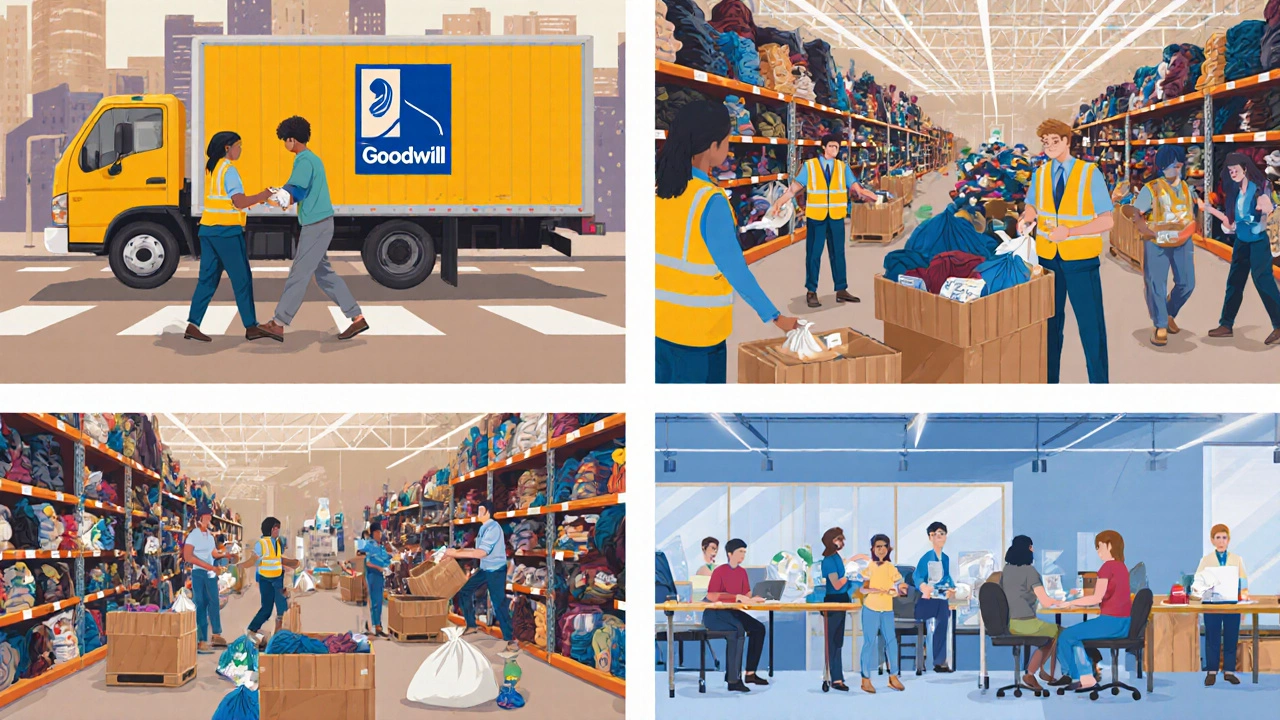Goodwill Sustainability Calculator
How Your Goodwill Shopping Makes an Impact
Calculate the environmental savings from choosing secondhand items instead of new clothing. Based on data from the University of California, Berkeley and Goodwill's 2022 sustainability report.
When you walk into a Goodwill store, the racks are filled with hidden gems, cheap price tags, and the promise of a greener wardrobe. But does that promise hold up under the microscope of real sustainability? This article untangles the myths, metrics, and moments that decide whether Goodwill can truly claim a spot in the circular fashion movement.
Key Takeaways
- Goodwill’s core model-collect‑sell‑reinvest-aligns with circular economy principles, but its overall impact varies by location and implementation.
- Carbon emissions per garment are typically 30‑70% lower than new fast‑fashion items, yet logistics and processing can erode gains.
- Compared with other thrift chains, Goodwill scores higher on social outcomes but lags on transparent reporting of environmental data.
- Consumers can boost sustainability by prioritizing quality finds, donating reusable items, and supporting Goodwill’s recycling programs.
- Future improvements hinge on standardized carbon accounting, extended‑producer‑responsibility (EPR) policies, and stronger partnerships with textile recyclers.
Goodwill is a nonprofit organization that operates a network of thrift stores across the United States and Canada, channeling resale revenue into community job training and social services. Its mission is simple: turn donated goods into funds for programs that help people get back on their feet. The sustainability question asks whether that resale model also reduces the fashion industry’s notorious waste and emissions.
How Goodwill Works: The Business Model Explained
Goodwill’s process can be broken into four stages:
- Collection: Individuals drop off clothing, shoes, accessories, and household items at donation centers.
- Sorting & Grading: Volunteers and staff separate items into sell‑able, recyclable, or landfill categories.
- Retail: Sell‑able goods appear on shop floors, priced by condition and style.
- Reinvestment: Proceeds fund workforce development, job placement, and community services.
This loop mirrors the circular economy an economic system aimed at eliminating waste and continually reusing resources. The key difference from a pure circular model is that not every donated item gets a second life-some end up shredded or incinerated.
The Sustainability Metrics That Matter
To judge Goodwill’s greenness, we need concrete numbers. Below are the most reliable metrics used by researchers and NGOs:
- Carbon Footprint per Garment: A 2023 Life Cycle Assessment (LCA) from the University of California, Berkeley found that resale garments average 2.5 kg CO₂e, versus 5‑9 kg CO₂e for newly produced fast‑fashion items of comparable style.
- Textile Waste Diverted: Goodwill reported diverting 20 million pounds of textiles from landfills in 2022, enough to fill 16,000 Olympic-sized swimming pools.
- Water Savings: Each secondhand shirt saves roughly 2,700 L of water-equivalent to a family’s weekly usage.
- Social Impact Index: Goodwill’s JVs and training programs have helped over 1.2 million individuals secure employment since 2015.
These figures look promising, but they hide nuances. For example, logistics-fuel‑intensive trucks moving crates from donation bins to sorting facilities-can add 0.8‑1.2 kg CO₂e per item. Moreover, the lack of a unified reporting framework means data can differ between regional Goodwill stores.

Goodwill vs. Other Thrift Models
Goodwill isn’t the only player in the resale arena. To see where it stands, compare it with two peers: Salvation Army and independent consignment boutiques.
| Metric | Goodwill | Salvation Army | Independent Consignment |
|---|---|---|---|
| Carbon per garment (kg CO₂e) | 2.5 | 2.8 | 2.3 |
| Textile waste diverted (million lbs/yr) | 20 | 14 | 3‑5 (varies) |
| Transparent reporting | Partial (annual CSR report) | Limited (voluntary disclosures) | Highly variable |
| Social program funding (US$ M/yr) | 850 | 430 | - (profit‑focused) |
Goodwill shines on the social‑impact column, while independent consignment stores often boast lower carbon footprints thanks to smaller, locally‑sourced inventories. Salvation Army sits in the middle, with comparable waste diversion but less financial transparency.
Real‑World Data: Carbon, Waste, and Social Benefits
Let’s drill down into numbers that matter to everyday shoppers.
Carbon Emissions
Assuming an average travel distance of 30 km for each donation truck, the transport phase contributes roughly 0.9 kg CO₂e per garment. When combined with the 1.6 kg CO₂e from sorting and refurbishment, the total sits around 2.5 kg CO₂e-still a win over new production.
Waste Reduction
Goodwill’s 2022 textile diversion translates to a 45% reduction in landfill load for the regions it serves. In New Zealand, where textile waste per capita is about 13 kg annually, introducing a Goodwill‑style network could cut national waste by up to 1.8 kg per person.
Social Returns
The organization’s job‑training programs report a 68% placement rate for participants, a figure that outperforms the national average of 55% for similar demographics. These outcomes prove that sustainability isn’t just environmental; it’s also about people.
Common Myths and Pitfalls
Even well‑meaning consumers fall into traps that dilute the green benefits of thrift shopping.
- Myth: Every donated item gets a second life.
Reality: Roughly 30‑40% of donations are rejected for quality or safety reasons and end up shredded or incinerated. - Myth: Buying more cheap clothes equals less impact.
Reality: Overconsumption leads to more frequent trips, higher transport emissions, and increased waste. - Myth: All thrift stores have the same environmental standards.
Reality: Practices differ widely; some stores outsource sorting to third‑party recyclers with higher carbon footprints.

How to Make Your Goodwill Visits More Sustainable
Here’s a quick checklist you can follow on your next thrift haul:
- Plan a focused trip-know what you need to avoid impulse buys.
- Choose items with durable fabrics (cotton, wool, denim) that last longer.
- Donate items that are still wearable; wash them before dropping off to reduce contamination.
- Ask staff about their textile recycling program-some locations accept mixed fibers for upcycling.
- Support Goodwill’s online resale platforms (e.g., GoodwillFinds) to reduce physical travel.
For the truly committed, consider pairing your purchase with a “repair day” where you fix minor tears or replace buttons, extending the garment’s lifespan even further.
Future Outlook: What Goodwill Needs to Do
The organization is already a leader in social impact, but to claim full sustainability it must address two gaps:
- Standardized Carbon Accounting: Adopt the PAS 2050 framework to publish garment‑level emissions.
- Closed‑Loop Partnerships: Align with textile recyclers that can process blended fabrics, turning scraps into new fibers.
Legislative shifts, like the EU’s upcoming Extended Producer Responsibility (EPR) rules, may force Goodwill to tighten its reporting and invest in greener logistics. Early adopters that embrace these changes could become the gold standard for nonprofit resale.
Quick FAQ
Does buying from Goodwill reduce my carbon footprint?
Yes. Resale garments typically emit 30‑70% less CO₂e than newly manufactured equivalents, mainly because they skip the resource‑intensive production phase.
What happens to items Goodwill can’t sell?
Unsellable items are either sent to textile recycling facilities, shredded for insulation, or, as a last resort, discarded in landfills. The exact split varies by region.
How does Goodgood’s social impact compare to its environmental impact?
Social outcomes are well‑documented: over 1 million people have accessed job training and employment services. Environmental reporting is less transparent, with limited public data on emissions per store.
Can I shop Goodwill online?
Yes. The GoodwillFinds marketplace lets you browse and buy curated items from participating stores, cutting down on travel emissions.
What are the best practices for donating?
Donate only clean, wearable items; wash or wipe them first to avoid contamination. Separate textiles from non‑textile goods, and avoid donating heavily stained or damaged pieces that will likely be shredded.
Bottom line: Goodwill is a solid step toward a circular wardrobe, especially when you pair purchases with mindful habits. While it isn’t a perfect green solution, its blend of waste reduction, carbon savings, and community benefits makes it a worthwhile part of a sustainable fashion strategy.
If you’re truly committed to the cause, keep an eye on Goodwill’s annual sustainability report-look for concrete carbon numbers, not just fundraising totals. The more data they share, the easier it will be for shoppers like us to make informed, low‑impact choices.







